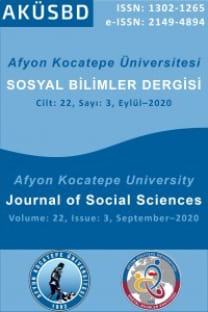Eco, Golding’in Geçiş Ayinleri ve Varoluşun Sınırlarını Aşmak
Eco, Golding’s Rites of Passage and Breaching the Limits of Being
Umberto Eco, William Golding, contractual realism, being, truth limit,
___
- Abrams, M.H. (1981). A Glossary of Literary Terms, New York: Holt, Rinehart, and Winston.
- Alter, R. (1975). Partial Magic: The Novel as a Self-Conscious Genre, Berkley and Los Angeles: University of California Press.
- Aristotle. (2016). Metaphysics. Indianapolis and Cambridge: Hackett Publishing Company.
- Aubenque, P. (1962). Aristotle and the Problem of Metaphysics, Paris: PUF.
- Boyd S. J. (1990). The Novels of William Golding. New York: Harvester Wheatsheaf.
- Braun, V. and Clarke, V. (2006). Using thematic analysis in psychology. Qualitative Research in Psychology, (3): 77-101.
- Byron, G. (1970). Poetical Works. London, Oxford and New York: Oxford University Press.
- Caesar, M. (2013). Umberto Eco: Philosophy, Semiotics and the Work of Fiction. Cambridge: Polity Press.
- Crawford, P. (2002). Politics and History in William Golding. The World Turned Upside Down.
- Columbia and London: University of Missouri Press.
- Crompton, D. (1985). A View from the Spire: William Golding’s Later Novels. Oxford: Blackwell.
- Di Martino, L. (2012). Between ‘New Realism’ and ‘Weak Thought’: Umberto Eco’s ‘Negative Realism’ and the Discourse of Late Postmodern Impegno. Quaderni d’Italianistica XXXIII, (2): 189-218.
- Dodds, E. R. (1951). The Greeks and the Irrational, Berkley and Los Angeles: University of California Press.
- Eco, U. (1988). The Aesthetics of Thomas Aquinas, Cambridge: Harvard University Press.
- Eco, U. (1999). Kant and the Platypus. Essays on Language and Cognition, London: Vintage. Eco, U. (2012). On Literature. London: Random House.
- Foucault, M. (1971). Madness and Civilization: A History of Insanity in the Age of Reason, London: Routledge.
- Gasiorek, A. (1995). Post-War British Fiction: Realism and After, London: Routledge. Gindin, J. (1988). William Golding, London: Macmillan.
- Golding, W. (1980). Rites of Passage, London: Faber and Faber.
- Golding, W. (2013). To the Ends of the Earth: A Sea Trilogy. London: Faber and Faber.
- Habermas, J. (1995). Peirce and Communication. In Peirce and Contemporary Thought, (edited by K. Ketner), New York: Fordham University Press.
- Haffenden, J. (1985). Novelists in Interview, London: Methuen.
- Holy Bible: King James Version Journaling Bible, (2014). New Orleans: Barbour Publishing.
- Hutcheon, L. (1995). Historiographic Metafiction. In Metafiction, (edited by M. Currie), London and New York: Longman.
- Kinkead-Weekes, M., and Gregor, I. (1984). William Golding: A Critical Study. London: Faber and Faber.
- Maguire, M., and Delahunt, B. (2017). Doing a Thematic Analysis: A Practical, Step-by-Step Guide for Learning and Teaching Scholars. AISHE-J. Autumn, (3): 1-14.
- Nietzsche, F. (1913). The Birth of Tragedy. In The Complete Works of Friedrich Nietzsche, (edited by O. Levy), Edinburgh and London: T.N. Foulis.
- Pacitti, D. (1999). Literary Philosophy, The Times Higher Education Supplement. January 22: 33.
- Peirce, C. S. (1983). Writings of Charles S. Peirce, Bloomington: Indiana University Press.
- Redpath, P. (1986). William Golding: A Structural Reading of His Fiction, London: Vision.
- Sevier, C. S. (2015). Aquinas on Beauty, New York and London: Lexington Books.
- Stancati, C. (2017). Umberto Eco: The Philosopher of Signs, Books & Ideas, September (25): 1- 10.
- Wilde, O. (1973). De Profundis and Other Writings, Harmondsworth: Penguin.
- ISSN: 1302-1265
- Yayın Aralığı: 4
- Başlangıç: 1999
- Yayıncı: Afyon Kocatepe Üniversitesi Sosyal Bilimler Enstitüsü
Yugoslavya’nın Dağılma Sürecinin Araçsalcı Bir Yaklaşımla Analizi
Tuğba SARIKAYA GÜLER, Hüseyin EMİROĞLU, Mürsel BAYRAM
Eco, Golding’in Geçiş Ayinleri ve Varoluşun Sınırlarını Aşmak
Yerel Kalkınmada Teknopark Modeli: Emilia-Romagna (İtalya) ve Shannon (İrlanda) Bölgeleri Örnekleri
Kadına Yönelik Şiddet Temalı Kamu Spotlarının Göstergebilimsel Çözümlemesi
Amerikan Basınında Türk-Ermeni Ortak Mandası Tartışmaları (1919-1920)
Sadık SARISAMAN, Burak ÇALIŞKAN
Rekreasyonel Liderlik ve İş Etiği: Animasyon Personeli Üzerine Bir Araştırma
Şerif Ahmet DEMİRDAĞ, Evren GÜÇER
Perihan ŞIKER, Hülya Tuğçe ÜLGER
Çalışanların Psikolojik Sermaye Alt Boyutlarının Demografik Özellikler Bağlamında Değişkenliği
Cem ŞEN, İbrahim Sani MERT, Kemal EROĞLUER
